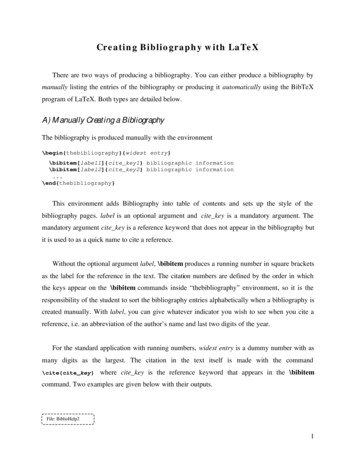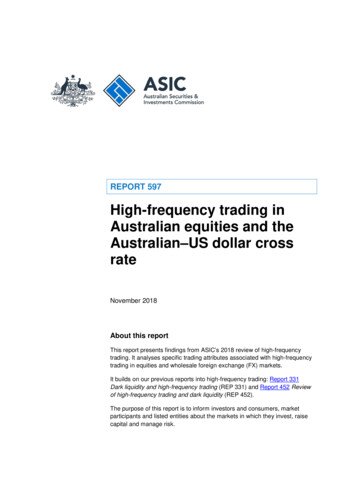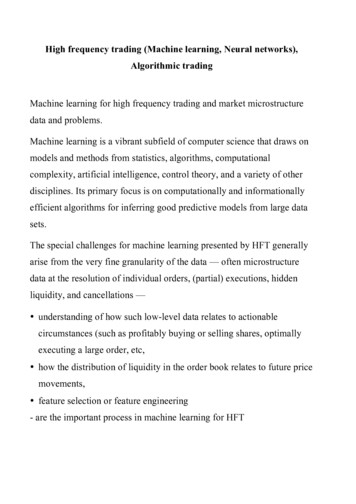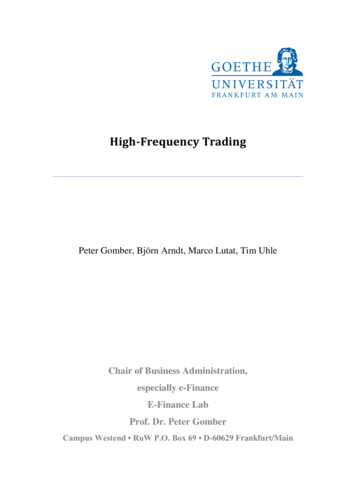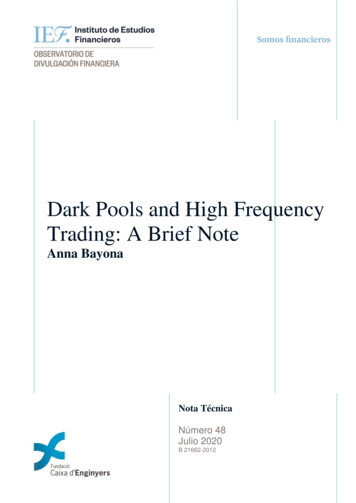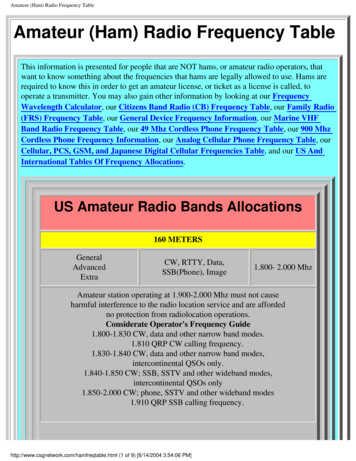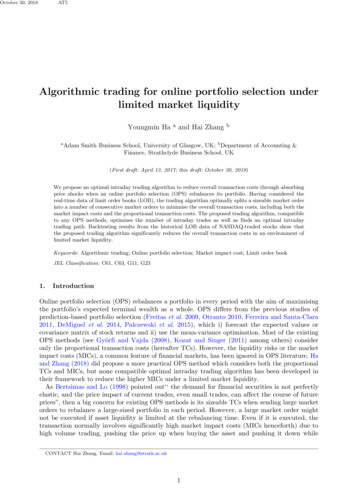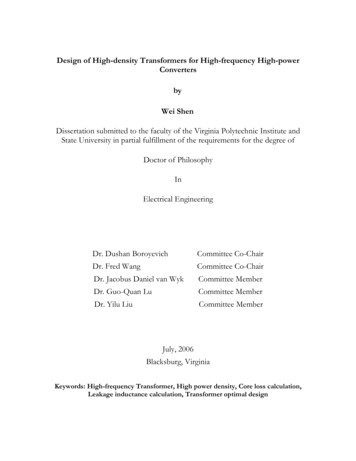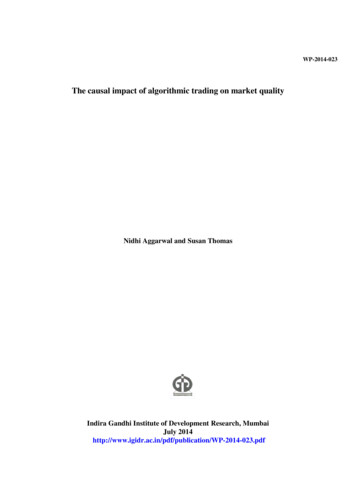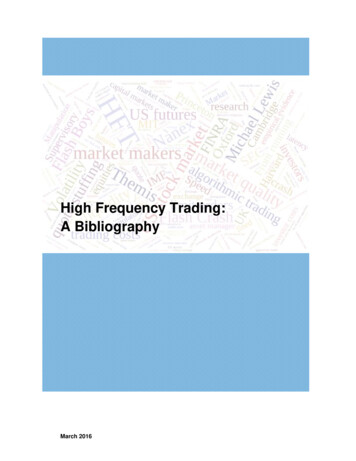
Transcription
High Frequency Trading:A BibliographyMarch 2016
ContentsPreface . 3Research Highlights . 4Volatility . 4Manipulation . 6Market Quality . 6Investor Costs . 8Evidence-Based Research Bibliography. 10The Wall Street Journal's "Dark Market" Series (selected articles) . 40High Frequency Trading and "Insider Trading 2.0" . 42Press Editorials . 43Op-Eds and Commentary . 45Books and Documentaries . 57"Flash Boys" by Michael Lewis . 6060 Minutes . 60Reviews . 60CNBC . 61Interviews . 61Other Interviews . 62"Flash Boys": Supporting Evidence . 62Government Reaction to HFT . 64Central Banks . 64Regulators . 66Legislators . 69Prosecutors . 70Other . 70High Frequency Trading Defined . 72Industry Participants . 72Academics . 72Regulators . 73High Frequency Trading:A Bibliography2
PrefaceThis is the fifth edition of a research bibliography on the negative effects of high frequency trading (HFT).It includes a wide variety of academic, government, and industry data-driven research from institutionsaround the world, including MIT, Harvard, Princeton, the Federal Reserve Bank, the Bank of England, theUniversity of Chicago, BlackRock, Cornell, the SEC, the European Central Bank, Yale, Oxford,Cambridge, the London School of Economics, the United Nations, the International Monetary Fund, andmany others.HFT research is especially relevant after the events of October 15, 2014, when yields on U.S. Treasuriesflash crashed, and the events of August 24, 2015, when U.S. stock markets suffered their second trilliondollar flash crash in five years. Among other topics, research posted here explores how the most commonhigh frequency trading business model today - unregulated or poorly regulated market making, oftencalled “scalping” - can be abusive and disruptive. Several of these studies even predate automation.Along with evidence-based research, separate sections of this bibliography include press editorials, opeds, other commentary, and a variety of statements from government bodies and government officialsfrom around the world about high frequency trading.This document begins with an overview and research highlights. A detailed research bibliographycontaining nearly 150 studies follows the highlights. Significant critical study findings are summarized orquoted in the highlights and the detailed bibliography. While this bibliography summarizes and excerptscritical findings, some studies cited here show mixed effects about high frequency trading. Interestedreaders can link to the full text of almost every included work.Please also note various industry, academic, and government definitions of high frequency trading listedin the final section of this document, and note the special section on Michael Lewis's "Flash Boys."R. T. LeuchtkaferMarch 2016High Frequency Trading:A Bibliography3
Research HighlightsVolatilityIn a 2010 study of the 2010 Flash Crash, the U.S. Securities and Exchange Commission and theCommodity Futures Trading Commission found that high frequency traders substantially increasedvolatility during the event and accelerated the crash. Kirilenko et. al. (2014) studied the 2010 FlashCrash and found the same, concluding that high frequency traders "can amplify a directional price moveand significantly add to volatility." Menkveld and Yueshen (2015) confirmed the U.S. government's andKirilenko's narratives about the Flash Crash. The U.S. Treasury, the Board of Governors of theFederal Reserve System, the Federal Reserve Bank of New York, the U.S. Securities and ExchangeCommission and the U.S. Commodity Futures Trading Commission released a Joint Staff Reportabout events on October 15, 2014, when "the market for U.S. Treasury securities, futures, and otherclosely related financial markets experienced an unusually high level of volatility." The report found highfrequency trading firm strategies "aggressively traded in the direction of price moves during the eventwindow, accounting for the bulk of the overall aggressive trading imbalance observed."Madhavan (2012) examined almost two decades of U.S. equities data and wrote that "The link to higherfrequency quotation activity and the current high levels of fragmentation help explain why a Flash Crashdid not occur before and offers a counterpoint to the view that the Flash Crash stemmed from an unlikelyconfluence of events." The Australian Securities and Investments Commission, the stock marketregulator in Australia, found in a 2013 study that during volatile markets high frequency traders reducetheir liquidity supply and increase their liquidity demands. After studying a decade's worth of U.S. data,Hasbrouck (2015) found that high frequency quoting increased a measure of intraday volatility by afactor of two or more.The Bank for International Settlements looked at foreign exchange markets and concluded in a 2011study that high frequency traders exacerbate volatility in stressed markets. In 2016 the Bank forInternational Settlements published a study of the recent evolution of sovereign debt markets and foundthat because of the adoption of algorithmic and high frequency trading "some market participants havehighlighted that while liquidity is ample in normal times, it may have become more fragile in episodes ofheightened demand for trading immediacy." Ben-David et. al (2012) studied 14 years of U.S. equity dataand concluded that "HFT can be highly destabilizing as it propagates shocks across markets at very highspeed." Bichetti et. al. (2012) examined 15 years of U.S. equities and futures data and determined thatHFT strategies cause assets to "deviate from their fundamentals." Boehmer et. al. analyzed nine yearsof stock market data from 37 countries and in a 2012 paper concluded that algorithmic trading, includinghigh frequency trading, caused higher volatility. Zhang (2010) studied 25 years of U.S. stock market dataand determined "high-frequency trading is positively correlated with stock price volatility." Huh (2014)found that high frequency traders withdraw during volatile markets, which exacerbates volatility. Kangand Shin (2012) looked at the Korean futures markets and concluded that "massive use of limit ordersincluding revision and cancellation by high frequency traders may potentially have negative effects on themarket." In Italy, Caivano (2015) found that "HFT activity causes a statistically and economicallysignificant increase in volatility."The U.K. Government Office for Science published a large 2012 study of capital markets around theworld and concluded that "HFT/AT may cause instabilities in financial markets in specific circumstances."Golub et. al. (2012) looked at six years of U.S. stock market data to study mini flash crashes anddetermined that "Given the speed and the magnitude of the crashes, it appears likely that Mini FlashCrashes are caused by HFT activity." Easley et. al. (2011) found that high frequency traders canHigh Frequency Trading:A Bibliography4
exacerbate price volatility when they dump inventory and withdraw from volatile markets, and that flashcrashes will recur because of U.S. market structure. Chung et. al. (2012) studied U.S. stock market datafrom two decades and wrote that higher volatility in asset prices in recent years is due in part to "theincreased role of high-frequency traders." Breckenfelder (2013) studied Swedish equities and found thatintraday volatility increased substantially when high frequency firms came to Sweden. Bain andMudassir (2013) found that though high frequency traders might narrow spreads, they increase intradayvolatility, and noted "an approximate doubling of short-term volatility resulting in higher implicit executioncosts for investors." Brogaard et. al. (2015) examined U.S. stock market data and concluded "OverallHFTs’ trading and HFTs’ short selling decreases liquidity by adversely selecting liquiditysuppliers.Hence, a conservative interpretation of the results is that a component of HFTs’ activity that isharmful. Consistent with a number of theoretical papers, the results suggest that a policy response toHFTs could include restrictions on HFTs."Benos and Sagade (2012) found that aggressive high frequency trading increased volatility in U.K. stockmarkets. Benos and Weatherilt (2012) found that "the de facto high-frequency market makers that haveentered markets following technological advances are free to enter or exit the market at will. This allowsthem to compete with DMMs when market-making is profitable but withdraw altogether from the marketwhen it is not." Nanex (2010-2016) has analyzed U.S. trading data from 2006 onward and foundthousands of events where individual stocks experienced unexplained violent price swings. Weller(2012) looked at U.S. futures data and wrote that "the introduction of fast, low capital intermediaries [highfrequency traders] can render markets less able to bear large liquidity demand shocks." The JointCFTC-SEC Advisory Committee on Emerging Regulatory Issues (2011), which included two Nobellaureates, examined U.S. market structure and data from the Flash Crash and wrote “In the presentenvironment, where high frequency and algorithmic trading predominate and where exchangecompetition has essentially eliminated rule-based market maker obligations, liquidity problems are aninherent difficulty that must be addressed. Indeed, even in the absence of extraordinary market events,limit order books can quickly empty and prices can crash simply due to the speed and numbers of ordersflowing into the market and due to the ability to instantly cancel orders.” Golub et. al. (2012) examinedU.S. equities data from 2006 through 2011 and found "strong evidence that Mini Flash Crashes have anadverse impact on market liquidity and are associated with Fleeting Liquidity." Raman et. al. (2014)looked at U.S. futures data and concluded that "in sharp contrast to the erstwhile locals in futures pits,electronic market makers reduce their participation and their liquidity provision in periods of significantlyhigh and persistent volatility.our results raise the question whether exchanges and regulators shouldconsider affirmative obligations for hitherto voluntary market makers." The United States Department ofthe Treasury et. al. (2015) studied Treasuries and futures trade data and noted "Another, and equallysignificant, group of PTF [high frequency trading firm] strategies appears to have aggressively traded inthe direction of price moves during the event window, accounting for the bulk of the overall aggressivetrading imbalance observed." The United States Federal Reserve Bank of New York's TreasuryMarket Practices Group (2015) studied Treasuries and futures trade data and concluded "the increasedadoption of automated trading has also led market participants and regulators to articulate concernsabout the potential for greater operational risk, disruptive market practices and trading strategies, and therisk of sharp, short -term disruptions to the Treasury securities market of the kind experienced in theequities and futures markets, which have a significant automated trading presence."High Frequency Trading:A Bibliography5
ManipulationEgginton et. al. (2012) found systematic evidence of "quote stuffing," a term coined by the market dataand research firm Nanex to describe the many events it found where exchange technology infrastructurewas slowed by floods of order and order cancel activity. They wrote that "We find that quote stuffing ispervasive with several hundred events occurring each trading day and that quote stuffing impacts over74% of US listed equities during our sample period," and found that "stocks experience decreasedliquidity, higher trading costs, and increased short term volatility.” Gao et. al. (2015) studied U.S. marketsfrom 2008 to 2013 and found "quote stuffing is harmful to market quality: prices become more volatile andbid-ask spreads rise." Direct Edge (2013) launched a service to help its customers "mitigate the risks" ofquote stuffing. Tse et. al. (2012) "present a detailed study of a variety of negative HFT strategiesincluding examples of Quote Stuffing, Layering/Order Book Fade, and Momentum Ignition to demonstratewhat bad HFT 'looks like', how often it happens, and how we detect it." Ye et. al. (2013) analyzed U.S.stock market data from 2010 and found "that stocks randomly grouped into the same [technology]channel have an abnormal correlation in message flow, which is consistent with the quote stuffinghypothesis." Industry regulator FINRA (2014) alleged a firm's high frequency trading customersemployed "aggressive, potentially destabilizing trading strategies in illiquid securities." The United StatesSecurities and Exchange Commission (2014) sanctioned a high frequency trading firm for manipulatingthe closing prices of thousands of stocks over a six month period. The United States CommodityFutures Trading Commission fined a trading firm 2.8 million for a "computer algorithm that wasdesigned to illegally place and quickly cancel bids and offers in futures contracts." The United States ofAmerica indicted (and later convicted) a trader who had "devised, implemented, and executed a highfrequency trading strategy in which he entered large-volume orders that he intended to immediatelycancel before they could be filled by other traders." The French regulator Autorité des MarchésFinanciers fined a global high frequency trading firm 5 million because its "huge volumes of extremelyrapid messages in the order books of the 27 securities gave, or were likely to have given, false ormisleading indications as to the supply and demand for those financial instruments, constituting a marketmanipulation as laid down in Article 631-1 of the AMF General Regulation."Market QualityBaron et. al. (2014) studied U.S. futures data and found a "winner-takes-all market structure" where"HFTs have strong incentives to take liquidity and compete over small increases in speed in an industrydominated by a small number of incumbents earning high and persistent returns." Biais and Foucault(2014) "recommend developing trading mechanisms that cater specifically to slow traders" and said "Thiscould require regulatory intervention to overcome exchanges' conflict of interests." Kim and Murphy(2013) examined more than a decade of U.S. stock market data and found that after controlling forchanges in market dynamics in that time period, market spreads were much worse than have beenreported. Kirilenko and Lo (2013) surveyed the research literature and concluded that "In contrast to anumber of public claims, high frequency traders do not as a rule engage in the provision of liquidity liketraditional market makers." Lee (2013) analyzed Korean futures data and found that "high frequencytrading is detrimental to the price discovery process." Machain and Dufour (2013) investigated U.K.stock market data and found empirical evidence for "a minimum period of time a limit order should be kepton the order book to avoid speculative practices." McInish and Upson (2012) explored U.S. equity dataand wrote that "the ability of fast liquidity suppliers to use their speed advantage to the detriment of slowliquidity demanders.unambiguously lowers market quality." Yildiz et. al. (2014) "provide empiricalevidence to support the theoretical predictions.that HFTs may play a dysfunctional role in financialmarkets." Van Kervel (2014) studied U.K. data and found that "trades are followed by excessivecancellations of limit orders, and the magnitude depends on the fraction of traders who can accessseveralHigh Frequency Trading:A Bibliography6
venues simultaneously" and "high-frequency traders can observe the first part of the trade and quicklycancel outstanding limit orders on other venues before the second part of the trade arrives." Afteranalyzing U.S. stock market data, Ye et. al. (2013) concluded that speed improvements do not improvespreads but do increase cancellations and volatility. Johnson et. al. (2013) "uncovered an explosion ofUEEs [ultrafast extreme events] starting in 2006, just after new legislation came into force that made highfrequency trading more attractive."The Australian Securities and Investments Commission (2013) reported that it found "some examplesof potentially predatory activity" and that it aggressively intervened with high frequency trading firms tochange their trading practices. Its efforts caused a "behavioural change by traders which has had amarked effect on market quality," including a 40% reduction in volatility in one part of the trading day.Analyzing Australian equities markets, Kwan and Philip (2015) attributed increased trading costs to"more predatory trading by HFT.we show that HFT are more successful in front-running non-HFT limitorders." Partington et. al. (2015) found that "evidence suggests that HFT trading strategies are likely todetract from, rather than add to, market quality." Boehmer et. al. (2012) studied trading data fromaround the world and discovered that "algorithmic traders can have impact beyond the immediate tradingenvironment and potentially affect the more fundamental functions of capital markets, such as theallocation of capital to firms." Boni et. al. (2012) found that excluding high frequency traders from amarket center resulted in lower volatility, less front running, and higher execution quality for institutionaltraders. Boulton et. al. (2012) analyzed U.S. stock market data from 2010 and discovered that"seemingly fleeting events, such as the flash crash, can have dramatic and lingering effects onshareholder wealth and market quality." Clark-Joseph (2013) explored U.S. futures data and found that"Aggressive trading is a tremendously important component of HFTs' activity. In aggregate, approximately48.5% of HFTs' volume is aggressive, and this figure rises to 54.2% among the 12 largest HFTs." Gerig(2015) studied U.S. equities and concluded that "HFT appears to make the financial system as a wholemore fragile."Nasdaq (2012) "observed that upon partial execution of a routable order at NASDAQ.marketparticipants often react to the order by cancelling their orders on other markets and entering new ordersat inferior prices." (A senior executive of a high frequency market maker, who is also head of an industrylobbying group, not long ago wrote "If I quote on 8 exchanges and get hit on one, I will update 16 prices.That is main reason for high [cancel] rates," offering strong evidence for Nasdaq's point; he then laterconfessed "market makers offer more liquidity than they're prepared to trade in one go.") Nanex (2014)analyzed the impact of one trader's order and found "sell orders simply disappeared before theexchanges processed his buy order."For a 12 million penalty, Knight Capital, one of the largest high frequency market makers in the world,settled charges in October 2013 with the U.S. Securities and Exchange Commission that Knight "didnot have adequate safeguards in place to limit the risks posed by its access to the markets, and failed asa result to prevent the entry of millions of erroneous orders." For a combined 375,000 penalty, the U.S.subsidiary of the Dutch firm IMC, one of the largest high-frequency market makers in the world, settledcharges in April 2013 with four U.S. stock exchanges including Nasdaq (2013) that it failed "to establishand maintain adequate supervisory procedures, including written supervisory procedures, and areasonable system of follow-up and review, related to the oversight of the Firm's high frequency andalgorithmic trading," as one of the settlements detailed. In July 2012, the Hong Kong Securities andFutures Commission fined an IMC subsidiary HK 1.5 million for "regulatory breaches and internalcontrol failings." For a 450,000 penalty, Getco, one of the largest high frequency market makers in theworld, settled charges in March 2012 with Nasdaq that one of its subsidiaries "failed to establish andmaintain a reasonable supervisory system, including but not limited to its written supervisory proceduresHigh Frequency Trading:A Bibliography7
and supervisory and operational risk control systems related to the oversight and operation of highfrequency trading and algorithmic trading." The CBOT found that a firm let a malfunctioning system rununinterrupted for 90 minutes while it sent "an excessive number of orders and cancelmessages.[accounting for] 88% of the messaging volume in the contract" and shut the system downonly after the exchange contacted the firm.In July 2013 FINRA and four U.S. exchanges fined Newedge USA a total of 9.5 million because the firm"failed to establish, maintain and enforce adequate supervisory systems and procedures, including writtensupervisory procedures that were reasonably designed to achieve compliance with applicable securitieslaws and regulations, including FINRA and exchange rules, addressing anti-money laundering and otherpotentially manipulative and suspicious trading activity by the Firm's DMA [electronic direct marketaccess] and SA [sponsored access] clients, such as spoofing, marking the close, excessive repetitiveorder entry, and wash sale transactions, numerous instances of which may have occurred on as many asfour exchanges." In November 2011 the CME Group fined Infinium Capital Management a total of 850,000 because, in part, the firm allowed "a malfunctioning ATS [automated trading system] to operatein a live trading environment." In August 2013 the China Securities Regulatory Commission finedEverbright Securities 85 million for "serious flaws" in its trading systems and controls that "directlyaffected the normal order of securities markets and caused violent stock price fluctuation" that joltedinvestors.The U.S. Federal Reserve Bank of Chicago studied a variety of proprietary trading firms, including highfrequency firms, and wrote in 2012 that "some firms do not have stringent processes for the development,testing, and deployment of code used in their trading algorithms" and that "out-of-control algorithms weremore common" than it expected.The United States Securities and Exchange Commission (2015) levied its largest fine ever against astock exchange for giving "information about certain order types only to some members, including certainhigh-frequency trading firms that provided input about how the orders would operate"; in 2016, it levied itslargest fines ever against dark pools for misleading subscribers about their operations.Investor CostsThe Industry Super Network is an association of Australian mutual funds. In a 2013 study, it estimatedthat high frequency traders cost long-term Australian investors an average A 1.6 billion a year. In theAustralian equities markets Kwan and Philip (2015) attributed increased trading costs to "more predatorytrading by HFT.we show that HFT are more successful in front-running non-HFT limit orders." NorgesBank Investment Management (2013), one of the largest funds in the world with nearly 1 trillion undermanagement, surveyed the research literature and concluded that "issues of concern to large, long-terminvestors more deserving of attention include –– Anticipation of large orders by some HFTs leading topotential adverse market impact –– Transient liquidity due to high propensity for HFTs to rapidly cancelquotes real-time –– Un-level playing field amongst market makers from low latency ultra HFT strategies."Pragma Securities (2012) examined U.S. stock trading in 2011 and 2012 and concluded that "highfrequency traders' ('HFTs') profits come at the expense of investors." Wah (2015) studied U.S. stockmarket data and estimated "that total potential profit from latency arbitrage opportunities in S&P 500 tickersymbols was approximately 3.03 billion in 2014."Nanex (2013) detailed episodes where high frequency traders had market-moving information worthmillions ahead of other investors despite widespread beliefs they did not. Rogers et. al. (2015) foundthat the SEC provided corporate filings to high-speed traders before providing them to the public.High Frequency Trading:A Bibliography8
McInish and Upson (2012) looked at U.S. stock market data and "show empirically that latencydifferences allow fast liquidity suppliers to pick off slow liquidity demanders at prices inferior to theNBBO." Hirschey (2013) examined U.S. stock market data and wrote that his analysis provides"evidence supporting the existence of an anticipatory trading channel through which HFTs may increasenon-HFT trading costs." Gao and Mizrach (2013) found that high frequency traders are more profitablewhen they trade against long-term investors than when they trade with other high frequency firms. TheQuantitative Services Group (2010) examined U.S. equity data and reported that "Changes in themicrostructure of equity markets and the emergence of HFT competitors have changed the nature andmagnitude of transaction costs. Sophisticated pattern recognition algorithms now present a real returnburden to active equity managers." Weller (2016) studied U.S. stock market data and found that"Although algorithmic liquidity provision may be associated with increased information acquisition, itseffects are swamped by the damage wrought by aggressive algorithmic traders."Tong (2013) studied U.S. stock data and found "strong evidence that HFT increases the trading costs ofinstitutional investors." Brogaard et. al. (2012) studied U.K. equities data from 2007 to 2011 and foundthat while institutional trading costs had declined in the period, high frequency trading had nothing to dowith it. Budish et. al. (2013) looked at U.S. futures and equities data from 2005 to 2011 and "show thatthe [HFT speed] arms race is socially wasteful – a prisoner’s dilemma built directly into the market design– and that its cost is ultimately borne by fundamental investors via wider spreads and thinner markets."Ding et. al. (2013) compared the relative speeds of national utility data feeds (typically used by long-terminvestors) and exchange proprietary data feeds (typically used by high frequency traders) and found asubstantial advantage for the proprietary data feeds, "While price dislocations have small effects oninfrequently trading invest
High Frequency Trading: 4 A Bibliography Research Highlights Volatility In a 2010 study of the 2010 Flash Crash, the U.S. Securities and Exchange Commission and the Commodity Futures Trading Commission found that high frequency traders substantially increas
